A Prototype Laboratory Environment for Digital Signal Processing Using Simulink and a Texas Instrument DSP Device
Normally, when a model is designed from building blocks in Simulink, the simulation is performed within the Simulink environment. A test of the design in a real-time environment requires that source code is generated, compiled and downloaded to the target hardware. As a first attempt to bridge this software gap, this thesis describes and evaluates a prototype laboratory environment, which directly links Simulink to a Texas Instrument DSP device. The prototype system converts graphical models and makes available various real-time signal processing algorithms, such as adders, delays, FFTs, IIR filters and multipliers. Future work is to consider modification of the prototype to allow for feedback in the graphical models and to find an efficient way of handling signal processing algorithms where variable buffer lengths are required.
A DGPS/Radiobeacon Receiver for Minimum Shift Keying with Soft Decision Capabilities
The Global Positioning System (GPS) is now in operation, and many improvements to its performance are being sought. One such improvement is Differential GPS (DGPS), where known errors in the GPS broadcast are identified and the corrections broadcast to the end user. One implementation of DGPS being considered is the use of coastal marine radio direction finding (RDF) radiobeacons in the 285-325kHz band as transmitters for the DGPS broadcast. The normal RDF beacon signal consists of a continuous carrier on a one kilohertz boundary plus a Morse-code identification signal 1025Hz above the carrier. In the DGPS/radiobeacon implementation proposed for the US coastal regions, the differential data link signal uses minimum shift keying (MSK) at a data rate of 25, 50, 100, 200 or 400 baud (the exact baud rat has not yet been decided). This MSK signal is centered between the RDF beacon carrier and identification signal. At the frequencies that these radiobeacons are operated, the prevailing atmospheric noise is both non-Gaussian and very strong. This noise characteristic makes the design of a long-range data link difficult. One solution that has been proposed is the use of forward error correction (FEC) coding of the data. The performance of FEC decoders can be improved by the used of a soft decision receiver, which delivers both bit decisions and information about the validity of the bit decisions. This work describes the design of a radio receiver for DGPS/Radiobeacon servics which is capable of reception of 400 baud MSK in the DGPS/Radiobeacon band. The receiver is designed to be easily augmented to provide soft decisions and easily modified to recieve MSK at data rates of 25 to 400 baud. The radio is a microprocessor controlled dual conversion superheterodyne with an audio frequency of 1kHz. The demodulator runs on the same microprocessor that controls the radio. The weak-signal performance of the demodulator is very good: the Eb/No vs. bit error rate performance of the demodulator is only a couple of dB worse than the theoretical performance of differential phase-shift keying. The radio has a noise floor of -114dBm referenced to it's 500Hz wide audio bandwidth and a 3rd order intermodulation intercept of +7dBm for a dynamic range of 83dB. This work concludes with a thumbnail analysis of the operations needed to implement a soft bit decision estimator, and some suggestions for the implementation of said soft bit decision estimator.
IMPLEMENTATION OF PERIODOGRAM SMOOTHING OF NOISYIMPLEMENTATION OF PERIODOGRAM SMOOTHING OF NOISY SIGNALS USING TMS320C6713 DSK
Periodogram Smoothing is a technique of power spectrum estimation. The discrete Fourier transform of a digital signal simply resolves the frequency components. The algorithm is implemented on Texas Instruments’ TMS320C6713 DSP Starter Kit (DSK). This is a 32-bit floating-point digital signal processor running at 225 MHz. The programs are basically written in the C programming language. However, those sections of code which are time-critical and memory-critical are written in assembly language of C6713. A MATLAB™ graphical user interface is also provided. The MATLAB™ program calls C programs loaded in Code Composer Studio (CCS). The C programs in turn call the assembly programs when required.
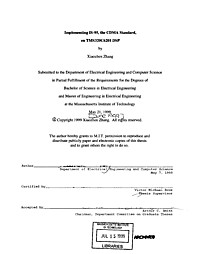
Implementing IS-95, the CDMA Standard, on TMS320C6201 DSP
IS-95 is the present U.S. 2nd generation CDMA standard. Currently, the 2nd generation CDMA phones are produced by Qualcomm. Texas Instruments (TI) has ASIC design for Viterbi Decoder on C54x. Several of the components in the forward link process are also implemented in hardware. However, having to design a specific hardware for a particular application is expensive and time consuming. Thus, the possibility of the alternative implementations is of great interest to both customers and TI itself. This research has achieved in successful implementation of IS-95 entirely in software on TI fixed-point DSP TMS320C6201, and met the real time constraint. IS-95 system, the industrial standard for CDMA, is a very complicated system and extremely computationally demanding. The transmission rate for an IS-95 system is 1.2288 Mcps. This research project includes all the major components of the demodulation process for the forward link system: PN Descrambling, Walsh Despreading, Phase Correction & Maximal Ratio Combining, Deinterleaver, Digital Automatic Gain Control, and Viterbi Deccc:r. The entire demodulation process is done completely in C. That makes it a very attractive alternative implementation in the future applications. It is well known that ASIC design is not only expensive and but also time consuming, programming in assembly is easier and cheaper, but programming in C is a much easier and efficient way out, in particular, for general computer engineers. During the whole process, efforts have been devoted on developing various specific techniques to optimize the design for all the components involved. These developments are successfully achieved by making the best use of the following techniques: to simplify the algorithms first before programming, to look for regularity in the problem, to work toward the Compiler's full efficiency, and to use C intrinsics whenever possible. All these attributes together make the implementation scheme great for DSP applications. The benchmark results compare very well to the TI-internal hand scheduled assembly performance of the same type of decoders. The estimated percentage usage of all the components (excluding PN) is only 21.18% of the total CPU cycles available (4,000 K), which is very efficient and impressive.
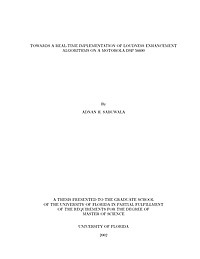
Towards a Real-Time Implementation of Loudness Enhancement Algorithms on a Motorola DSP 56600
Most of the cellular phone companies with audio speaker capabilities focus on reducing the current drain to extend battery life. None of these companies concentrate on modifying the speech signal itself to make it sound louder in noisy listener environments without adding additional energy. Such algorithms have been described in literature by Boillot and form the backbone of this thesis. The current project focusses on taking a step towards running these algorithms in real-time on a 16-bit fixed point Motorola DSP 56600. Implementation of the autocorrelation, Levinson- Durbin, FIR, and IIR filters in assembly for the Motorola DSP 56600 has been investigated in the thesis. The challenges and alternate solutions to circumvent the challenges have been described, and experimental results have been presented. Results indicate that the modified signed LMS algorithm, which can be considered to be a blend between the LMS and signed LMS algorithms, turns out to be an elegant solution to circumvent the challenges in implementing the Levinson-Durbin recursion.
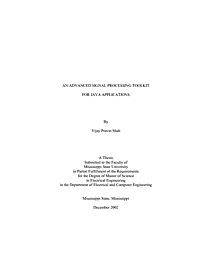
An Advanced Signal Processing Toolkit for Java applications
The aim of this study is to examine the capability, performance, and relevance of a signal processing toolkit in Java, a programming language for Web-based applications. Due to the simplicity, ease and application use of the toolkit and with the advanced Internet technologies such as Remote Method Invocation (RMI), a spectral estimation applet has been created in the Java environment. This toolkit also provides an interactive and visual approach in understanding the various theoretical concepts of spectral estimation and shows the need to create more application applets to better understand the various concepts of signal and image processing. This study also focuses on creating a Java toolkit for embedded systems, such as Personal Digital Assistants (PDAs), embedded Java board, and supporting integer precision, and utilizing COordinate Rotation DIgital Computer (CORDIC) algorithm, both aimed to provide good performance in resource-limited environments. The results show a feasibility and necessity of developing a standardized Application Programming Interface (API) for the fixed-point signal processing library.
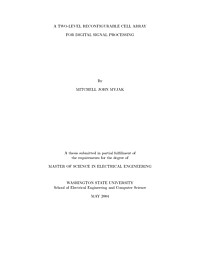
A Two-Level Reconfigurable Cell Array for Digital Signal Processing
Reconfigurable hardware has become an attractive option for implementing digital signal processing, especially in systems that require both high performance and flexibility. This thesis presents a novel two-level reconfigurable architecture targeted toward systems with these requirements. The architecture supports a large orthogonal design space whereby designers can customize the word length, amount of parallelism, number of functional units, and functional unit connectivity to meet the needs of the application. On the upper level, algorithms are mapped onto an array of 4-bit cells and a hierarchical interconnection fabric. The interconnection structure contains a mesh of 4-bit busses for local data transfer, as well as an H-tree for communicating results between functional units. On the lower level, each cell contains a small matrix of elements that collectively implement all necessary operations. The matrix of elements has only two configurations: one optimized for mathematical functions such as multiply-accumulates, and the other optimized for memory operations. The system also contains pipeline latches to maximize clock rate and throughput. Circuit simulations indicate that the architecture achieves a clock frequency of 200 MHz in a modest 0.25-μm CMOS technology. An initial prototype of the reconfigurable cell has been fabricated in 0.5-μm CMOS and tested for functionality. The estimated execution time for a 16-bit, 256-point Fast Fourier Transform shows a speedup ranging from 1.6 to 14 compared to contemporary digital signal processors.
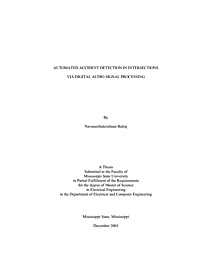
Automated Accident Detection in Intersections Via Digital Audio Signal Processing
The aim of this thesis is to design a system for automated accident detection in intersections. The input to the system is a three-second audio signal. The system can be operated in two modes: two-class and multi-class. The output of the two-class system is a label of “crash” or “non-crash”. In the multi-class system, the output is the label of “crash” or various non-crash incidents including “pile drive”, “brake”, and “normal-traffic” sounds. The system designed has three main steps in processing the input audio signal. They are: feature extraction, feature optimization and classification. Five different methods of feature extraction are investigated and compared; they are based on the discrete wavelet transform, fast Fourier transform, discrete cosine transform, real cepstrum transform and Mel frequency cepstral transform. Linear discriminant analysis (LDA) is used to optimize the features obtained in the feature extraction stage by linearly combining the features using different weights. Three types of statistical classifiers are investigated and compared: the nearest neighbor, nearest mean, and maximum likelihood methods. Data collected from Jackson, MS and Starkville, MS and the crash signals obtained from Texas Transportation Institute crash test facility are used to train and test the designed system. The results showed that the wavelet based feature extraction method with LDA and maximum likelihood classifier is the optimum design. This wavelet-based system is computationally inexpensive compared to other methods. The system produced classification accuracies of 95% to 100% when the input signal has a signal-to-noise-ratio of at least 0 decibels. These results show that the system is capable of effectively classifying “crash” or “non-crash” on a given input audio signal.
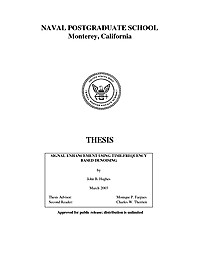
Ignal Enhancement Using Time-Frequency Based Denoising
This thesis investigates and compares time and wavelet-domain denoising techniques where received signals contain broadband noise. We consider how time and wavelet-domain denoising schemes and their combinations compare in the mean squared error sense. This work applies Wiener prediction and Median filtering as they do not require any prior signal knowledge. In the wavelet-domain we use soft or hard thresholding on the detail coefficients. In addition, we explore the effect of these wavelet-domain thresholding techniques on the coefficients associated with cycle-spinning and the newly proposed recursive cycle-spinning scheme. Finally, we note that thresholding does not make an attempt to de-noise coefficients that remain after thresholding; therefore we apply time domain techniques to the remaining detail coefficients from the first level of decomposition in an attempt to de-noise them further prior to reconstruction. This thesis applies and compares these techniques using a mean squared error criterion to identify the best performing in a robust test signal environment. We find that soft thresholding with Stein’s Unbiased Risk Estimate (SURE) thresholding produces the best mean squared error results in each test case and that the addition of Wiener prediction to the first level of decomposition coefficients leads to a slightly enhanced performance. Finally, we illustrate the effects of denoising algorithms on longer data segments.
Active control of automobile cabin noise with conventional and advanced speakers
Recently much research has focused on the control of enclosed sound fields, particularly in automobiles. Both Active Noise Control (ANC) and Active Structural Acoustic Control (ASAC) techniques are being applied to problems stemming from power train noise and road noise (noise due to the interaction of the tires with the surface of the road). Due to the low frequency characteristics of these noise problems, large acoustic sources are required to obtain efficient control of the sound field. This creates demand in the automobile industry for compact lightweight sources. This work is concerned with the application of active control to power train noise, as well as road noise in the interior cabin of a sport utility vehicle using advanced, compact lightweight piezoelectric acoustic sources. First, a test structure approximately the same size as the automobile was built to study the principles of active noise control in a cavity. A finite element model of the cavity was created in order to optimize the positions of the error sensors and the control sources. Experimental work was performed with the optimized actuator and sensor locations in order to validate the model, and draw conclusions regarding the conditions to obtain global control of the sound field. Second, a broad-band feedforward filtered-X LMS algorithm was used to control power train noise. Preliminary power train noise tests were conducted using arrangements of four microphones and up to four commercially available speakers for control. Attenuation of seven decibel (dB) at the error sensors was measured in the 40-500 Hz frequency band. The dimensions of the zone of quiet generated by the control were measured, and show that noise reductions were obtained for a large volume surrounding the error sensors. Next, advanced speakers were implemented for active control of power train noise. The results obtained with different arrangements of these speakers were very similar to those obtained with the commercially-available speakers. These advanced speakers use piezoelectric devices to induce the displacement of a speaker membrane, which radiates sound. Their lighter weight and compact dimensions are a significant advantage over conventional speakers, for their application in automobile. Third, preliminary results were obtained for active control of road noise. The controller used an optimized set of four reference signals to control the noise at one error sensor using one control source. Two sets of tests were conducted. The first set of tests was performed on a dynamometer, which simulates the effects of the road on the tires. The second set of tests was performed on a rough road. Reduction of two to four decibel of the sound pressure level at the error sensor was obtained between 100 and 200 Hz.
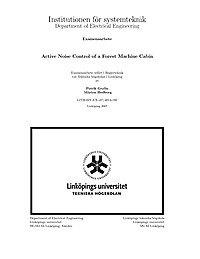
Active Noise Control of a Forest Machine Cabin
Today, a high noise level is considered a problem in many working environments. The main reason is that it contributes to stress and fatigue. Traditional methods using passive noise control is only practicable for high frequencies. As a complement to passive noise control, active noise control (ANC) can be used to reduce low frequency noise. The main idea of ANC is to use destructive interference of waves to cancel disturbing noises. The purpose of this thesis is to design and implement an ANC system in the driver's cabin of a Valmet 890 forest machine. The engine boom is one of the most disturbing noises and therefore the main subjective for the ANC system to suppress. The ANC system is implemented on a Texas Instrument DSP development starter kit. Different FxLMS algorithms are evaluated with feedback and feedforward configurations. The results indicate that an ANC system significantly reduces the sound pressure level (SPL) in the cabin. Best performance of the evaluated systems is achieved for the feedforward FxLMS system. For a commonly used engine speed of 1500 rpm, the SPL is reduced with 17 dB. The results show fast enough convergence and global suppression of low frequency noise.
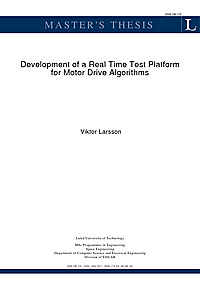
Development of a real time test platform for motor drive algorithms
In this thesis a real time test platform for a permanent magnet synchronous motor is developed. The implemented algorithm is Field Oriented Control (FOC) and it is implemented on a Texas Instruments TMS320F2808 Digital Signal Processor (DSP). The platform is developed in a rapid prototyping approach using Matlab/Simulink and the Real Time Workshop (RTW) packages.With this software the control algorithm and its interface to different DSP modules, such as A/D converter and PWM module, is constructed as a Simulink block scheme. The blocks used come from ordinary Simulink libraries and libraries provided by the RTW packages. From the Simulink block scheme Matlab can auto generate embedded C code adapted for different embedded targets, in this case the 2808 DSP.The developed real time test platform is also a Simulink model, though different from the algorithm model. When the start simulation command is given in the platform model a Graphical User Interface is loaded which lets the user specify motor parameters and certain algorithm parameters. Once the parameters are chosen RTW generates code from the algorithm model, loads it into the DSP and runs the generated program. From the platform model it is possible to set the reference speed of the motor in real time and monitor/log motor parameters such as actual speed and stator currents.

Implementing IS-95, the CDMA Standard, on TMS320C6201 DSP
IS-95 is the present U.S. 2nd generation CDMA standard. Currently, the 2nd generation CDMA phones are produced by Qualcomm. Texas Instruments (TI) has ASIC design for Viterbi Decoder on C54x. Several of the components in the forward link process are also implemented in hardware. However, having to design a specific hardware for a particular application is expensive and time consuming. Thus, the possibility of the alternative implementations is of great interest to both customers and TI itself. This research has achieved in successful implementation of IS-95 entirely in software on TI fixed-point DSP TMS320C6201, and met the real time constraint. IS-95 system, the industrial standard for CDMA, is a very complicated system and extremely computationally demanding. The transmission rate for an IS-95 system is 1.2288 Mcps. This research project includes all the major components of the demodulation process for the forward link system: PN Descrambling, Walsh Despreading, Phase Correction & Maximal Ratio Combining, Deinterleaver, Digital Automatic Gain Control, and Viterbi Deccc:r. The entire demodulation process is done completely in C. That makes it a very attractive alternative implementation in the future applications. It is well known that ASIC design is not only expensive and but also time consuming, programming in assembly is easier and cheaper, but programming in C is a much easier and efficient way out, in particular, for general computer engineers. During the whole process, efforts have been devoted on developing various specific techniques to optimize the design for all the components involved. These developments are successfully achieved by making the best use of the following techniques: to simplify the algorithms first before programming, to look for regularity in the problem, to work toward the Compiler's full efficiency, and to use C intrinsics whenever possible. All these attributes together make the implementation scheme great for DSP applications. The benchmark results compare very well to the TI-internal hand scheduled assembly performance of the same type of decoders. The estimated percentage usage of all the components (excluding PN) is only 21.18% of the total CPU cycles available (4,000 K), which is very efficient and impressive.
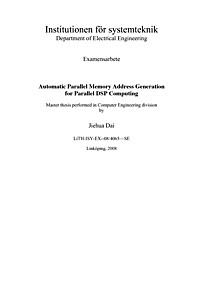
Automatic Parallel Memory Address Generation for Parallel DSP Computing
The concept of Parallel Vector (scratch pad) Memories (PVM) was introduced as one solution for Parallel Computing in DSP, which can provides parallel memory addressing efficiently with minimum latency. The parallel programming more efficient by using the parallel addressing generator for parallel vector memory (PVM) proposed in this thesis. However, without hiding complexities by cache, the cost of programming is high. To minimize the programming cost, automatic parallel memory address generation is needed to hide the complexities of memory access. This thesis investigates methods for implementing conflict-free vector addressing algorithms on a parallel hardware structure. In particular, match vector addressing requirements extracted from the behaviour model to a prepared parallel memory addressing template, in order to supply data in parallel from the main memory to the on-chip vector memory. According to the template and usage of the main and on-chip parallel vector memory, models for data pre-allocation and permutation in scratch pad memories of ASIP can be decided and configured. By exposing the parallel memory access of source code, the memory access flow graph (MFG) will be generated. Then MFG will be used combined with hardware information to match templates in the template library. When it is matched with one template, suited permutation equation will be gained, and the permutation table that include target addresses for data pre-allocation and permutation is created. Thus it is possible to automatically generate memory address for parallel memory accesses. A tool for achieving the goal mentioned above is created, Permutator, which is implemented in C++ combined with XML. Memory access coding template is selected, as a result that permutation formulas are specified. And then PVM address table could be generated to make the data pre-allocation, so that efficient parallel memory access is possible. The result shows that the memory access complexities is hiden by using Permutator, so that the programming cost is reduced.It works well in the context that each algorithm with its related hardware information is corresponding to a template case, so that extra memory cost is eliminated.
Wavelet Filter Banks in Perceptual Audio Coding
This thesis studies the application of the wavelet filter bank (WFB) in perceptual audio coding by providing brief overviews of perceptual coding, psychoacoustics, wavelet theory, and existing wavelet coding algorithms. Furthermore, it describes the poor frequency localization property of the WFB and explores one filter design method, in particular, for improving channel separation between the wavelet bands. A wavelet audio coder has also been developed by the author to test the new filters. Preliminary tests indicate that the new filters provide some improvement over other wavelet filters when coding audio signals that are stationary-like and contain only a few harmonic components, and similar results for other types of audio signals that contain many spectral and temporal components. It has been found that the WFB provides a flexible decomposition scheme through the choice of the tree structure and basis filter, but at the cost of poor localization properties. This flexibility can be a benefit in the context of audio coding but the poor localization properties represent a drawback. Determining ways to fully utilize this flexibility, while minimizing the effects of poor time-frequency localization, is an area that is still very much open for research.
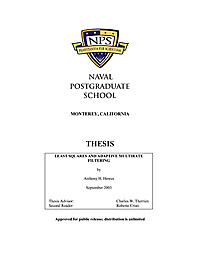
Least Squares and Adaptive Multirate Filtering
This thesis addresses the problem of estimating a random process from two observed signals sampled at different rates. The case where the low–rate observation has a higher signal–to– noise ratio than the high–rate observation is addressed. Both adaptive and non–adaptive filtering techniques are explored. For the non–adaptive case, a multirate version of the Wiener–Hopf optimal filter is used for estimation. Three forms of the filter are described. It is shown that using both observations with this filter achieves a lower mean–squared error than using either sequence alone. Furthermore, the amount of training data to solve for the filter weights is comparable to that needed when using either sequence alone. For the adaptive case, a multirate version of the LMS adaptive algorithm is developed. Both narrowband and broadband interference are removed using the algorithm in an adaptive noise cancellation scheme. The ability to remove interference at the high rate using observations taken at the low rate without the high–rate observations is demonstrated.
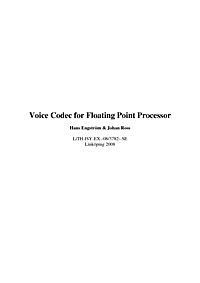
Voice Codec for Floating Point Processor
As part of an ongoing project at the department of electrical engineering, ISY, at Linköping University, a voice decoder using floating point formats has been the focus of this master thesis. Previous work has been done developing an mp3-decoder using the floating point formats. All is expected to be implemented on a single DSP.The ever present desire to make things smaller, more efficient and less power consuming are the main reasons for this master thesis regarding the use of a floating point format instead of the traditional integer format in a GSM codec. The idea with the low precision floating point format is to be able to reduce the size of the memory. This in turn reduces the size of the total chip area needed and also decreases the power consumption.One main question is if this can be done with the floating point format without losing too much sound quality of the speech. When using the integer format, one can represent every value in the range depending on how many bits are being used. When using a floating point format you can represent larger values using fewer bits compared to the integer format but you lose representation of some values and have to round the values off.From the tests that have been made with the decoder during this thesis, it has been found that the audible difference between the two formats is very small and can hardly be heard, if at all. The rounding seems to have very little effect on the quality of the sound and the implementation of the codec has succeeded in reproducing similar sound quality to the GSM standard decoder.
Signal Processing Requirements for WiMAX (802.16e) Base Station
802.16e provides specifications for non line of sight, mobile wireless communications in the frequency range of 2-6 GHz. It is well implemented by using OFDMA as its physical layer scheme. The OFDM symbol time (sT) is to be selected depending on the channel conditions, available bandwidth and, simulations provide a means of selecting right values of sTin different channel conditions. Additionally it has been shown that certain values of sT outperform others in all conditions, thus invalidating their use. Moreover, a solution proposed by INTEL is also analyzed. One of the major requirements of OFDM is high synchronization. Detecting the timing offset of a new mobile user, entering the network, which is not time aligned using cross-correlation and ‘auto-correlation’ in time domain and cross-correlation in frequency domain at the base station has been simulated. Results point that the processing load can be significantly reduced by using frequency domain correlation of the received data or by using ‘auto-correlation’ followed by cross-correlation on localized data. The use of adaptive antenna system in 802.16e improves the system performance, where beamforming is implemented in the direction of desired user. Capon’s method and MUSIC method have been simulated to compute the direction of arrival for OFDMA uplink. A new user, while in the ranging process, transmits data with unknown time offset and unknown direction. The thesis describes the procedure to find the two unknown one after another.
IMPLEMENTATION OF PERIODOGRAM SMOOTHING OF NOISYIMPLEMENTATION OF PERIODOGRAM SMOOTHING OF NOISY SIGNALS USING TMS320C6713 DSK
Periodogram Smoothing is a technique of power spectrum estimation. The discrete Fourier transform of a digital signal simply resolves the frequency components. The algorithm is implemented on Texas Instruments’ TMS320C6713 DSP Starter Kit (DSK). This is a 32-bit floating-point digital signal processor running at 225 MHz. The programs are basically written in the C programming language. However, those sections of code which are time-critical and memory-critical are written in assembly language of C6713. A MATLAB™ graphical user interface is also provided. The MATLAB™ program calls C programs loaded in Code Composer Studio (CCS). The C programs in turn call the assembly programs when required.

Towards a Real-Time Implementation of Loudness Enhancement Algorithms on a Motorola DSP 56600
Most of the cellular phone companies with audio speaker capabilities focus on reducing the current drain to extend battery life. None of these companies concentrate on modifying the speech signal itself to make it sound louder in noisy listener environments without adding additional energy. Such algorithms have been described in literature by Boillot and form the backbone of this thesis. The current project focusses on taking a step towards running these algorithms in real-time on a 16-bit fixed point Motorola DSP 56600. Implementation of the autocorrelation, Levinson- Durbin, FIR, and IIR filters in assembly for the Motorola DSP 56600 has been investigated in the thesis. The challenges and alternate solutions to circumvent the challenges have been described, and experimental results have been presented. Results indicate that the modified signed LMS algorithm, which can be considered to be a blend between the LMS and signed LMS algorithms, turns out to be an elegant solution to circumvent the challenges in implementing the Levinson-Durbin recursion.


















